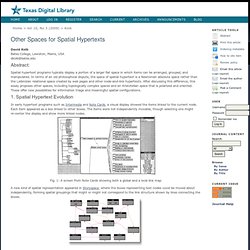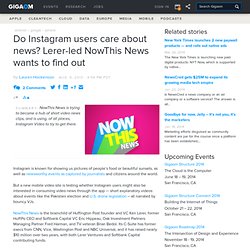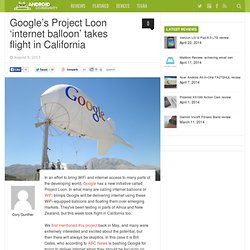

Change.org: 40M users and still not a server in sight. Change.org, the platform behind all those online petitions — the justice for Trayvon Martin petition is one recent example — uses a ton of technology, just not a lot of it in-house.

Change.org’s Tom Hughes-Croucher The company now claims it serves 40 million users, up from 20 million from a year ago and 25 million last January, and it still doesn’t have a server in sight. Leaflet - a JavaScript library for mobile-friendly maps. Hashtags. Other Spaces for Spatial Hypertext. 1.

Spatial Hypertext Evolution In early hypertext programs such as Intermedia and Note Cards, a visual display showed the items linked to the current node. Each item appeared as a box linked to other boxes. The items were not independently movable, though selecting one might re-center the display and show more linked nodes. Fig. 1: A screen from Note Cards showing both a global and a local link map. A new kind of spatial representation appeared in Storyspace, where the boxes representing text nodes could be moved about independently, forming spatial groupings that might or might not correspond to the link structure shown by lines connecting the boxes.
Fig. 2: A Storyspace map showing movable boxes connected by link arrows. Loc.alize.us - Explore your world through everyone's eyes. Can OpenGeocoder Fill the Platform Gap Left by Google Maps? How do machines understand what place you're talking about when you say the name of a city, a street or a neighborhood?

With geocoding technology, that's how. Every location-based service available uses a geocoder to translate the name of a place into a location on a map. But there isn't a really good, big, stable, public domain geocoder available on the market. Steve Coast, the man who lead the creation of Open Street Map, has launched a new project to create what he believes is just what the world of location-based services needs in order to grow to meet its potential. Yevvo For iPhone Debuts A New Take On Live Broadcasting. Newly launched mobile broadcasting app Yevvo has a different idea about how live mobile video apps should work.

Instead of focusing only on a social model where users find and follow other people on the service, Yevvo users can also follow places in the real world, as well as events. Beyond its own walls, the app mainly targets the Twitter ecosystem and is designed to be push-button simple. One tap and slide and your entire Twitter network is alerted that you are live and on-air. Yevvo’s focus is just on live video for now. Currently, only the broadcaster can save the video to his or her iPhone library when the video ends, but more options will be added in the future. Today, there are, of course, a number of tools for recording and sharing live video. Early Innovations. Do Instagram users care about news? Lerer-led NowThis News wants to find out. Instagram is known for showing us pictures of people’s food or beautiful sunsets, as well as newsworthy events as captured by journalists and citizens around the world.

But a new mobile video site is testing whether Instagram users might also be interested in consuming video news through the app — short explanatory videos about events like the Pakistani election and U.S. drone legislation – all narrated by bouncy VJs. NowThis News is the brainchild of Huffington Post founder and VC Ken Lerer, former HuffPo CEO and Softbank Capital VC Eric Hippeau, Oak Investment Partners Managing Partner Fred Harman, and TV veteran Brian Bedol. Its C-Suite has former execs from CNN, Vice, Washington Post and NBC Universal, and it has raised nearly $10 million over two years, with both Lerer Ventures and Softbank Capital contributing funds. The 40-person company (roughly equally mixed between production and business) churns 18 to 25, mostly minute-long, videos a day.
Google’s Project Loon ‘internet balloon’ takes flight in California. In an effort to bring WiFi and internet access to many parts of the developing world, Google has a new initiative called Project Loon.

Gpicsync - Automatically geocode pictures from your camera and a GPS track log. Trapit. Yevvo For iPhone Debuts A New Take On Live Broadcasting. The Future Of Google’s Plan To Bring The Entire World Internet With Balloons. The history of Google’s moonshot project to provide global Internet access using high-altitude balloons goes back nearly 1800 years, according to Google[x] chief technical architect Rich Devaul.

That’s when, according to legend, a Chinese general sent a floating lantern into the sky to call for more troops. Devaul first began to consider how to blanket the world with balloon-based wireless Internet closer to a decade ago, when he was at the MIT Media Lab. “I got as far as a napkin sketch,” Devaul says. “No balloons were inflated at that time.” The fundamental insight that would fuel the now (literally) full-blown project at Google[x] was of the “fast, cheap and out of control” variety. The fruit of that idea is “Project Loon,” which launched its first public trial last month in New Zealand, using 30 balloons to try to bring wireless signals to 50 testers including sheep-farming entrepreneur Charles Nimmo.